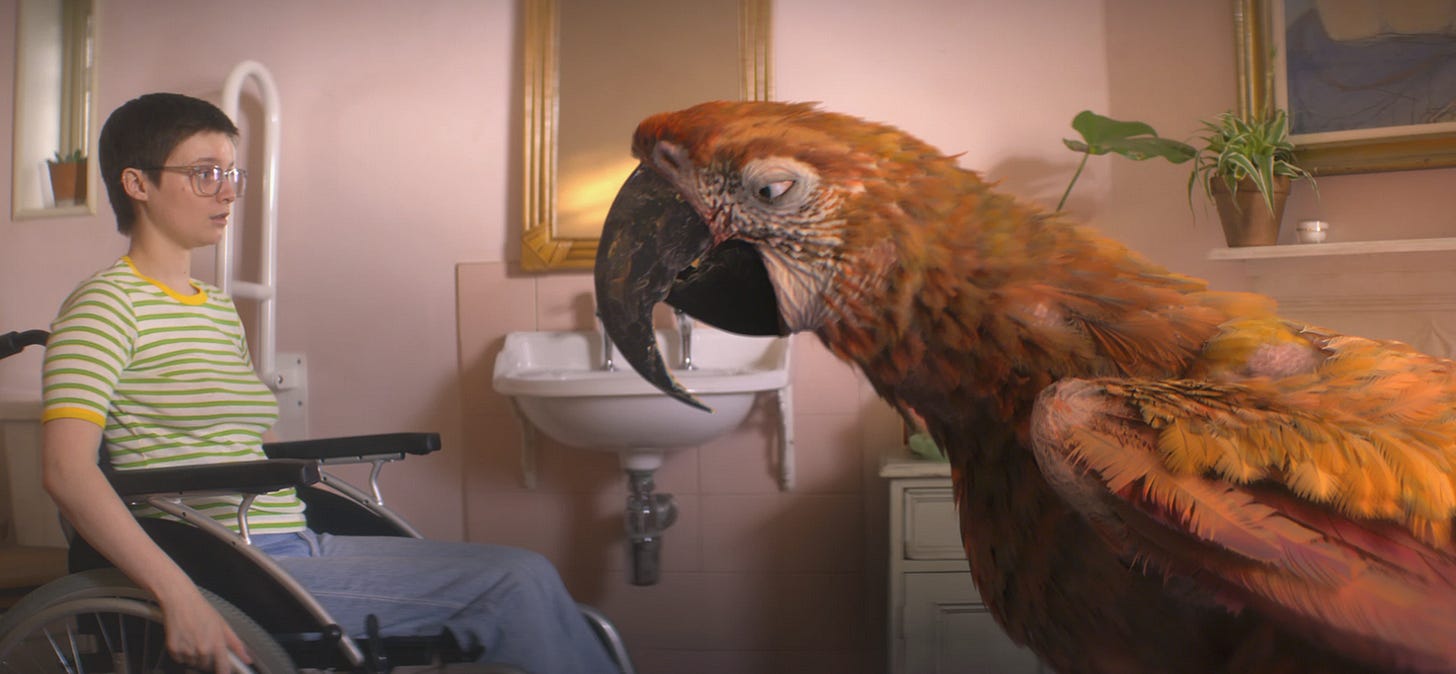In today’s post, we’re looking at the emotional superstructure of Daina O. Pusić’s feature directorial debut Tuesday, which was released across the U.S. on June 14, 2024. You may also recognize this film by it’s more official name: The Julia Louis-Dreyfus Movie With the Bird.
This is a film I could see myself enjoying more on a second watch, because I especially like how it ended and it would be interesting to see how all the scenes are building to that point, once one knows what it is. That said, the craft breakdown below does contain spoilers, but they are more about the story’s big picture message than any surprise twist or plot point.
The Emotional Superstructure of “Tuesday”
A terminally ill teen and her mother must accept that Death—a talking, size-shifting macaw—will soon take her away.
How to Create an Afterlife for the Living
For most of my life, I’ve seen Death personified as a grim reaper, a skeleton, a cloaked and hooded figure with a scythe, perhaps with an hourglass and wings. A figure to simply fear.
New storytelling possibilities open up when one portrays Death as a bird instead.
Death as envisioned in Tuesday can still be menacing, as the reactions of several people meeting their demises as the character is introduced onscreen clearly illustrate.
But this Death is also—befriendable. And Tuesday, the terminally ill teen whose head we’re in for much of the first part of the film, is ready to befriend Death.

Death is just as interested in this friendship because Tuesday is unique in her ability to quiet the incessant cacophony of voices in Death’s head, all living beings close to their deaths who are pleading for Death to come and take them.
This key aspect of Death’s embodiment emphasizes how necessary Death is, within the world of the story and of course in our world. So does a middle section of the film in which Tuesday’s mother, Zora, is able to temporarily put Death out of commission. The suffering of the dying is needlessly prolonged and hoards of pests multiply.
If it’s hard to say that Death is ever desirable, exactly, it’s also easy to see that the absence of Death—or the inability of Death to do their work—is also not exactly desirable. The storytellers remind us of the ways that Death is necessary to life. (At least in a world where people don’t remain in good health forever and living beings reproduce.)
Tuesday is able to make her peace early on with Death, except for worrying—with good reason—about how her mother will fare after she’s gone.
Julia Louis-Dreyfus’s character Zora is far more resistant and ready to fight Death off, in any way she can think of, to keep her daughter alive. It is, perhaps, much easier to befriend Death when they’re coming for you than when they’re coming for the person you love most in the world.
We know Zora willl have no choice in the end, that Death will eventually take her daughter. It is important to this story’s superstructure that Tuesday is terminally ill, that there is no question about whether she will die, but only what Zora will do with herself after a loss that strikes at the core of her identity and world, that seems barely survivable.
Tuesday befriends Death so her mother has time to get used to the idea, and so she can emphasize that her only concern is that her mother will be okay after she’s gone.
“You’ll be okay,” Tuesday practically commands, as the end is drawing near. “Promise?”
Zora promises, repeating the word many times.
Zora is never quite going to befriend Death or have a moment when she’s ready for Death to take Tuesday from her. But she does allow Death to satisfy some of her curiosity, and in the process provide wise advice about how to live, once Tuesday is gone.
Zora asks Death if there is an afterlife and Death tells her that it’s more like the dead leaving their echos in the world of the living. In other words, Tuesday lives on in Zora and how Zora lives is essentially Tuesday’s afterlife. "The echo you leave, the legacy, your memory, is how she lives."
Tuesday can no longer act in the world, but Zora still can, on her behalf. And one of the biggest things Tuesday wanted was for Zora to be okay. So, it’s now up to Zora to keep her most important promise and go find a way to be okay in the world.
Are afterlives mostly for the living? I like the elegance of this system, which has no need to resort to any supernatural element—other than a talking, size-shifting parrot—to evoke a powerful vision of an afterlife that exists entirely in the world of the living.
If someone in the world of the living cares about you enough to act in your memory, or out of love for you, you have an afterlife. And if you love someone enough to act this way for them, then your loved one is in an afterlife, one that you have the power to craft.
Using only the elements in the superstructure, the creators of this story have offered up a compelling vision of afterlives, a framing that encourages any of us to embrace the powers we have to transform grief into the will to go on living.
The macaw that is Death can now disappear from Zora’s world and ours—outside the movie theatre—completely, but we’re still empowered by their practical magic.
The storytellers gave Death a form that captures both the fear death inspires and invites other ways of seeing and relating to Death that go beyond fear.
Key takeaway for story creators: If you want to show a character’s changing relationship with an unseeable force, give it a visual form that invites this change.





